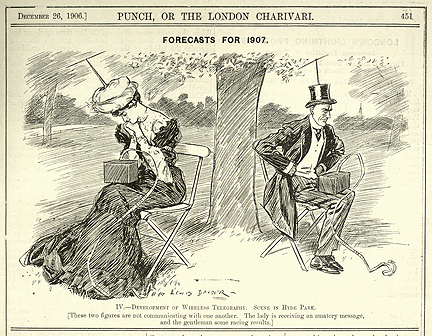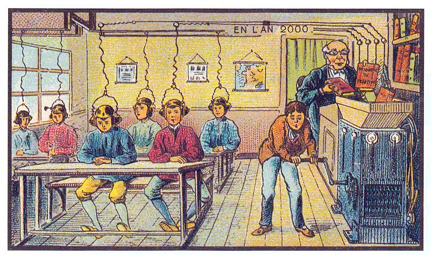
 I have found some very interesting articles recently in the
Public Domain Review. They flash back 100 years ago to see what people thought
life would be like in our day. Of course, most of them missed the mark, as you
would expect. The cutting-edge technology in travel was in airplanes, so there
were a lot of predictions about everyone strapping on a propeller driven
backpack and flying everywhere we needed to go in the 21st Century.
However, there were some predictions that came eerily close to being right.
These predictions were in the area of how we communicate with each other.
I have found some very interesting articles recently in the
Public Domain Review. They flash back 100 years ago to see what people thought
life would be like in our day. Of course, most of them missed the mark, as you
would expect. The cutting-edge technology in travel was in airplanes, so there
were a lot of predictions about everyone strapping on a propeller driven
backpack and flying everywhere we needed to go in the 21st Century.
However, there were some predictions that came eerily close to being right.
These predictions were in the area of how we communicate with each other.
The first image above comes from Punch Magazine in December 1906. The illustration shows two people
sitting next to each other. They are each holding a wireless telegraph box with
ticker tape running out of it – their own personal communications
device. You will notice that each of them also has an antenna sticking out the
top of their hats. The caption stresses they are not communicating with each
other, but the lady is receiving an "amatory message” and the man is
receiving "racing results.” The prediction was that we would be so
engrossed by our communications devices that we would not speak to a person
sitting right next to us. You may notice that this was a prediction for the
year 1907 – the year after the illustration was published. In any case,
exchange that large telegraph box with a Smart Phone and you have 2016!
The second image is from a group of post cards that were
produced for the 1900 World Exhibition in Paris. It shows a school teacher
feeding books into a grinding machine that then deciphers the content of the
books and reads them to students who are listening to them audibly with
earphones. Again, this French artist comes pretty close to the way we receive
information in the 21st Century. No longer do we go to a library,
check out books, read them page-by-page and then return them to the library.
Printed information is old news. Information is readily available, free of
charge, on any internet browser. Students now use iPads to get lessons. I teach
a college class where all the information is passed electronically. Tests are
taken, graded and recorded online. Students never have to turn in anything
tangible or tactile to me.
Now lets put these two ideas together and tell me what we
have in the year 2016. The main form of communicating and gathering information
in our world is a wireless device we call a phone, but is rarely used to call
anyone. The phone has become a replacement for books, photos, libraries,
magazines, newspapers, TV, video, radio, and nearly any other communication
medium we have used in marketing over the past 100 years. People in the same
vicinity will choose to text each other and express themselves in emojis before
they would look you in the eye and speak to you. Information that people will
read is very short. We live in a world that does not have time for in-depth
content. Therefore, people will react to sound bites that may have nothing to
do with reality, but it will be believed. (If you doubt me, take a look at the
current presidential process.)
So what does someone who is in charge of marketing
communication do with all of this? First, use the world of mobile technology to
your marketing benefit. Make sure you are finding a way to engage with your
marketplace through a Smartphone. This is imperative. Second, make sure your
communications are short and to the point. No one will wade through a couple
thousand words to read your content. Bullet point your main features and get to
the point in all your communications. Third, guard your company brand by making
sure what is said about you online is factual. Fix the facts. Little things
said about you can go viral and be blown way out of proportion. Your future as
a company depends upon good marketing communications.